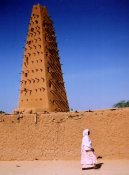Niger
Niger: Travel tips, articles, photos, gallery, cities database, population, pics, flags, statistics, free maps online
Back to Countries, Click to read the whole article: Niger
| Introduction - Niger: | | Location - Niger: | | People - Niger: | | Government - Niger: | | Economy - Niger: | Economy overview | Niger is one of the poorest countries in the world, ranking last on the United Nations Development Fund index of human development. It is a landlocked, Sub-Saharan nation, whose economy centers on subsistence crops, livestock, and some of the worlds largest uranium deposits. Drought cycles, desertification, and a 2.9% population growth rate, have undercut the economy. Niger shares a common currency, the CFA franc, and a common central bank, the Central Bank of West African States (BCEAO), with seven other members of the West African Monetary Union. In December 2000, Niger qualified for enhanced debt relief under the International Monetary Fund program for Highly Indebted Poor Countries (HIPC) and concluded an agreement with the Fund on a Poverty Reduction and Growth Facility (PRGF). Debt relief provided under the enhanced HIPC initiative significantly reduces Nigers annual debt service obligations, freeing funds for expenditures on basic health care, primary education, HIV/AIDS prevention, rural infrastructure, and other programs geared at poverty reduction. In December 2005, Niger received 100% multilateral debt relief from the IMF, which translates into the forgiveness of approximately US $86 million in debts to the IMF, excluding the remaining assistance under HIPC. Nearly half of the governments budget is derived from foreign donor resources. Future growth may be sustained by exploitation of oil, gold, coal, and other mineral resources. Uranium prices have increased sharply in the last few years. A drought and locust infestation in 2005 led to food shortages for as many as 2.5 million Nigeriens. | | Gdp purchasing power parity | $12.36 billion (2006 est.) | | Gdp official exchange rate | $3.638 billion (2006 est.) | | Gdp real growth rate | 3.5% (2006 est.) | | Gdp per capita ppp | $1,000 (2006 est.) | | Gdp composition by sector | agriculture: 39%
industry: 17%
services: 44% (2001) | | Labor force | 70,000 salaried workers, 60% of whom are employed in the public sector (2002 est.) | | Labor force by occupation | agriculture: 90%
industry: 6%
services: 4% | | Unemployment rate | NA% | | Population below poverty line | 63% (1993 est.) | | Household income or consumption by percentage share | lowest 10%: 0.8%
highest 10%: 35.4% (1995) | | Distribution of family income gini index | 50.5 (1995) | | Inflation rate consumer prices | 0.2% (2004 est.) | | Budget | revenues: $320 million (includes $134 million from foreign sources)
expenditures: $320 million; including capital expenditures of $178 million (2002 est.) | | Agriculture products | cowpeas, cotton, peanuts, millet, sorghum, cassava (tapioca), rice; cattle, sheep, goats, camels, donkeys, horses, poultry | | Industries | uranium mining, cement, brick, soap, textiles, food processing, chemicals, slaughterhouses | | Industrial production growth rate | 5.1% (2003 est.) | | Electricity production | 232 million kWh (2004) | | Electricity consumption | 415.8 million kWh (2004) | | Electricity exports | 0 kWh (2004) | | Electricity imports | 200 million kWh (2004) | | Oil production | 0 bbl/day (2004 est.) | | Oil consumption | 5,500 bbl/day (2004 est.) | | Oil exports | NA bbl/day | | Oil imports | NA bbl/day | | Oil proved reserves | 0 bbl | | Natural gas production | 0 cu m (2004 est.) | | Natural gas consumption | 0 cu m (2004 est.) | | Exports | $222 million f.o.b. (2004 est.) | | Exports commodities | uranium ore, livestock, cowpeas, onions | | Exports partners | France 34.8%, US 26.5%, Nigeria 18.3%, Russia 11.3% (2006) | | Imports | $588 million f.o.b. (2004 est.) | | Imports commodities | foodstuffs, machinery, vehicles and parts, petroleum, cereals | | Imports partners | US 14.2%, France 12.2%, China 7.9%, Nigeria 7.8%, French Polynesia 7.8%, Cote dIvoire 5% (2006) | | Debt external | $2.1 billion (2003 est.) | | Economic aid recipient | $453.3 million (2003) | | Currency code | Communaute Financiere Africaine franc (XOF); note - responsible authority is the Central Bank of the West African States (BCEAO) | | Exchange rates | Communaute Financiere Africaine francs (XOF) per US dollar - 522.59 (2006), 527.47 (2005), 528.29 (2004), 581.2 (2003), 696.99 (2002) | |
| Communications - Niger: | | Transportation - Niger: | | Military - Niger: |
This page was last updated on 16 September, 2007
Source: CIA >>> |




